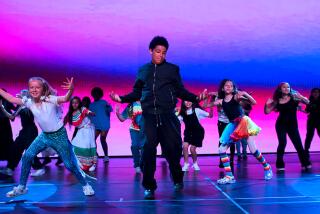OC LIVE : DANCE : Escape to Alcatraz : Native American Seizure of the Island Inspired Choreographer
On a chilly November night in 1969, a group of about 90 Native Americans boarded two small boats and sailed from Sausalito to Alcatraz, the federal prison that had been closed six years earlier. When they landed, they proclaimed ownership of the island as “free Indian land” by ancestral “right of discovery.” It was, at least in part, a protest against centuries of land-grabbing at the expense of Native Americans.
They stayed on the island for the next 19 months, despite objections from the federal government, subsequent defections from their ranks, public support waxing and waning, and several grave incidents, including the death of a 12-year-old girl who was killed in a fall from a cellblock stairwell.
Only 15 Native Americans were left on Alcatraz when federal marshals finally arrived June 11, 1971, to remove them. The island was subsequently turned over to the National Park Service.
Among the event’s other legacies, it was the inspiration for a ballet, “A Song for Dead Warriors,” choreographed by Michael Smuin in 1977. It will be danced Friday at 8 p.m. and Saturday and Sunday at 2 p.m. by Dance Theatre of Harlem during the company’s engagement at the Orange County Performing Arts Center in Costa Mesa. (Another Smuin ballet, “Medea,” will be danced Saturday and Sunday at 8 p.m.)
“The takeover of Alcatraz captured the imagination of the country, especially for that long a time,” Smuin said in a recent phone interview from his home in San Francisco. “I kept close tabs on them. Eventually I came up with a libretto based on that situation. It was not necessarily a retelling of that event. I use other things.”
The “other things” allow Smuin to create a ballet about the oppression of the American Indian. The work includes tribal dances, racist villains, ethnic rape, beatings, a stabbing and a scalping. In the Dance Theatre of Harlem production, the racist sheriff appears with his face painted white. The color, Smuin said, was added by company director Arthur Mitchell.
“Arthur thought it was a good idea,” he said. “It’s not necessarily white face, but a skull, a death face, which people interpret as a white face. You already have a death look anyway because the dancers wear these sunglasses that are mirrored. . . . Arthur wanted to take it a step further, and that was fine with me.”
The same year that he choreographed “Song,” he also created “Medea” to music of Samuel Barber--music that Barber had written for Martha Graham’s 1946 ballet, “Cave of the Heart.”
*
Both ballets are based on the ancient Greek myth in which the sorceress Medea wreaks horrible revenge when her husband, Jason, deserts her for his new wife, Creusa.
“I was always partial to that Barber score,” Smuin said. “I had never seen the Martha Graham ballet. I decided to take a shot at it. If I had seen it, I might not have done mine. Since then, however, I’ve seen it several times. Mine is so different. Mine is more a literal telling of the story.
“Martha Graham’s is what might have gone on in [the characters’] inner feelings. It’s more of a mind thing,” he said. “Mine has a literal story line. It’s more of a narrative.”
Smuin created both works for San Francisco Ballet, which he led from 1973 to 1984. Dance Theatre of Harlem, however, is the only company dancing these works today, he said.
“I’ve known Arthur for so many years,” he said. “We knew each other when he was dancing in New York City Ballet and I was in American Ballet Theatre. We were always close friends.”
Smuin said he relies on such personal connections when it’s time to create a new work.
“I have a story line and the people I want to use, for whatever part, in mind,” he said. “But the actual steps don’t happen until I’m in the studio with my dancers.”
Most of all, however, he said, “I really spend a lot of time with the music, in some cases to the point where I could conduct it.”
Does he ever get stuck?
“Oh, God, yes. Some ballets you do from start to finish,” he said. “Others, you get a real block and wonder, ‘How can I fix that?’ Both of those particular ballets went from beginning to end.”
Even so, “ ‘Warriors’ was difficult to do because in fact I was taking a European art form and putting an American story to it. It had to be carefully done. So much had to be invented in terms of steps. The only real Indian dancing is a 45-second section called ‘Pow Wow.’ That’s real Indian dancing, but that’s the only thing in it. The rest is classically based.
“ ‘Medea’ was classically based like ‘Warriors,’ but it was easier to do. Still, there’s a lot of invention in it.
“It seems like I did those ballets yesterday,” Smuin added. “Of course it was a long time ago. Sometimes I like visiting old friends. Other times, I think, ‘What was I thinking of then?’
“These ballets?” he asked himself. “They’ve held up.”
* DANCE LISTINGS, F17
* Who: Dance Theatre of Harlem.
* When: Friday through Sunday at 8 p.m.; Saturday and Sunday at 2 p.m.
* Where: Orange County Performing Arts Center, 600 Town Center Drive, Costa Mesa.
* Whereabouts: San Diego (405) Freeway to Bristol Avenue exit north. Turn right from Bristol onto Town Center Drive.
* Wherewithal: $18 to $55.
* Where to call: (714) 556-2787.
More to Read
The biggest entertainment stories
Get our big stories about Hollywood, film, television, music, arts, culture and more right in your inbox as soon as they publish.
You may occasionally receive promotional content from the Los Angeles Times.










